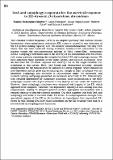Por favor, use este identificador para citar o enlazar a este item:
http://hdl.handle.net/10261/189595COMPARTIR / EXPORTAR:
 SHARE
BASE SHARE
BASE
|
|
| Visualizar otros formatos: MARC | Dublin Core | RDF | ORE | MODS | METS | DIDL | DATACITE | |

| Título: | IreA and autophagy cooperate for the survival response to ER-stress in Dictyostelium discoideum |
Autor: | Domínguez-Martín, Eunice CSIC; Kawasaki, Laura; Ongay-Larios, Laura; Coria, Roberto; Escalante, Ricardo CSIC ORCID | Fecha de publicación: | 2017 | Citación: | Dicty 2017 | Resumen: | The Unfolded Protein Response (UPR) is an adaptive pathway that restores cellular homeostasis when endoplasmic reticulum (ER) stress is caused by any alteration of the ER protein folding capacity. Ire1 ER-resident kinase/ribonuclease, the only UPR sensor that has been conserved during evolution, transmits ER information to the nucleus trough the non-conventional splicing of Hac1 (yeast)/Xbp1 (metazoans) mRNA. Autophagy contributes also to the recovery of cell homeostasis after ER-stress; still, many questions regarding the interplay between UPR and autophagy remain. We have addressed these questions in the model system Dictyostelium discoideum; first, we described the ER-stress response and identify IreA as the single bonafide Ire1 orthologue in this system. Both, IreA kinase and ribonuclease activities, resulted indispensable for the tunicamycin(TN)-induced ER-stress response; which induced an ireA-dependent specific gene expression program, though an Xbp1 orthologue was not identified. Autophagy was activated in Dictyostelium under TN treatment, and mutants lacking autophagy presented an increased sensitivity to TN. Interestingly, IreA resulted dispensable for autophagy activation, since accumulation of the early autophagic marker GFP-Atg18 occurred in the absence of IreA under TN treatment. However, these autophagic structures were abnormal and trapped at the ER, which appeared to be collapsed. Therefore, the degradative capacity of IreA-lacking cells was compromised, leading to ubiquitin-positive protein aggregates accumulation and a reduced capacity to degrade cytosolic proteins. Our data suggests that both IreA and autophagy contribute to survival under ER stress. As autophagosomes emerges from specialized regions of the ER in Dictyostelium we hypothesize that unresolved ERstress in cells lacking IreA may cause alterations on the ER structure that lead to a late blockade in autophagosome formation. | Descripción: | Resumen del trabajo presentado a la Annual Dictyostelium Confrence, celebrada en Geneva (Switzerland) del 20 al 24 de agosto de 2017. | URI: | http://hdl.handle.net/10261/189595 |
| Aparece en las colecciones: | (IIBM) Comunicaciones congresos |
Ficheros en este ítem:
| Fichero | Descripción | Tamaño | Formato | |
|---|---|---|---|---|
| ireadisco.pdf | 120,89 kB | Adobe PDF |  Visualizar/Abrir |
CORE Recommender
Page view(s)
183
checked on 03-may-2024
Download(s)
54
checked on 03-may-2024
Google ScholarTM
Check
NOTA: Los ítems de Digital.CSIC están protegidos por copyright, con todos los derechos reservados, a menos que se indique lo contrario.
